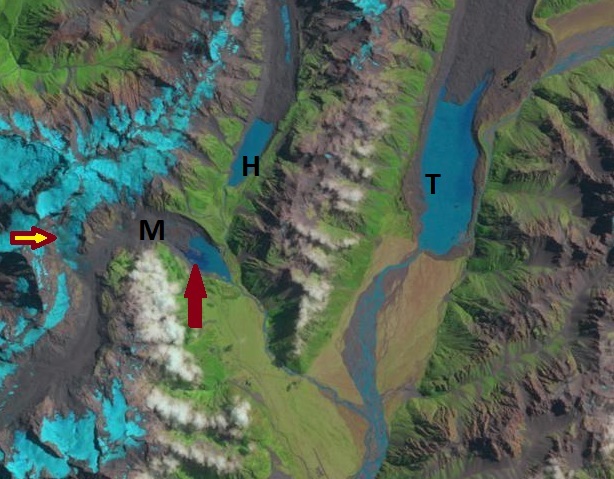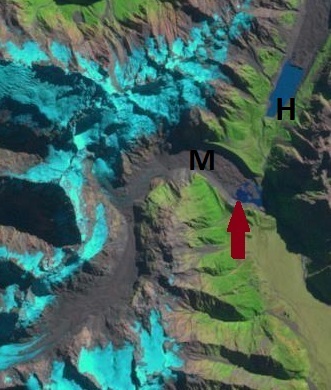Volume loss in New Zealand glaciers is dominated by 12 large glaciers. The NIWA glacier monitoring program has noted that volume of ice in New Zealand’s Southern Alps has decreased 5.8 cubic kilometres, more than 10% in the past 30 years. More than 90% of this loss is from 12 of the largest glaciers in response to rising temperatures over the 20th century. Three of these glaciers are the Tasman, Mueller and Hooker Glacier. Mueller and Hooker Glacier are one valley west of the Tasman Glacier and end in the same valley ending just 3 km apart. Description of the retreat and the role of glacier lakes in accelerating the reteat of Tasman Glacier is discussed in detail in Dykes et al (2011). If we look back to the 1972 Mount Cook Map no lakes are evident at the terminus of Hooker (H), Mueller (M) or Tasman Glacier(T), pink dots indicate terminus location, top image. In 2011 the Landsat image illustrates that this has become a new lake district, bottom image.
 . Mueller Glacier drains the eastern side of Mount Sefton, Mount Thompson and Mount Isabel. The lower section of the glacier is debris covered in the valley reach from the terminus at 1000 m to 1250 m. A comparison of the Mueller Glacier in a sequence of three Landsat images below from 2000 (top), 2004 (middle) and 2011 (bottom), indicates that the lake at the end of Hooker Glacier had developed by 2000. The lake at the end of the Mueller Glacier was just forming length of 400 meters. By 2004 the Mueller Glacier Lake had expanded to a length of 700 meters. By 2011 the lake had reached 1400 meters in length. The 1000 meter retreat from 2000-2011 will continue in the future as the lower section is stagnant.
. Mueller Glacier drains the eastern side of Mount Sefton, Mount Thompson and Mount Isabel. The lower section of the glacier is debris covered in the valley reach from the terminus at 1000 m to 1250 m. A comparison of the Mueller Glacier in a sequence of three Landsat images below from 2000 (top), 2004 (middle) and 2011 (bottom), indicates that the lake at the end of Hooker Glacier had developed by 2000. The lake at the end of the Mueller Glacier was just forming length of 400 meters. By 2004 the Mueller Glacier Lake had expanded to a length of 700 meters. By 2011 the lake had reached 1400 meters in length. The 1000 meter retreat from 2000-2011 will continue in the future as the lower section is stagnant. 

 . A closer look at the lower Mueller Glacier indicates that the lower 2 km is stagnant as indicated by the formation of supraglacial lakes and considerable surface roughness (green arrow) that does not occur when a glacier is active and moving. The glacier has been fed by three different glaciers flowing off of Mount Sefton. Two of them Tuckett and Huddlesoton (pink arrow) are no longer delivering significant ice to the Mueller, only modest avalanching now spills onto the Mueller Glacier. Only the Frind Glacier (yellow arrow) is contributing to the Mueller Glacier. The result is that the end of truly active ice is at the purple arrow, this will develop into the terminus of the Mueller Glacier. In the 2011 image of the glacier the yellow-burgundy arrow indicates the snowline on the Frind Glacier is at 1900 meters, yielding too small of an accumulation zone to support the valley tongue of the Mueller Glacier. This is similar to the situation on nearby Murchison Glacier. Further the lack of ice connection from Huddleston and Tuckett Glaciers to Mueller is again evident, pink arrow. The lake will continue to expand through minor calving and downwasting. The lake has not been surveyed, but seems to lack the depth at the current terminus of Tasman Lake where calving can be more important.
. A closer look at the lower Mueller Glacier indicates that the lower 2 km is stagnant as indicated by the formation of supraglacial lakes and considerable surface roughness (green arrow) that does not occur when a glacier is active and moving. The glacier has been fed by three different glaciers flowing off of Mount Sefton. Two of them Tuckett and Huddlesoton (pink arrow) are no longer delivering significant ice to the Mueller, only modest avalanching now spills onto the Mueller Glacier. Only the Frind Glacier (yellow arrow) is contributing to the Mueller Glacier. The result is that the end of truly active ice is at the purple arrow, this will develop into the terminus of the Mueller Glacier. In the 2011 image of the glacier the yellow-burgundy arrow indicates the snowline on the Frind Glacier is at 1900 meters, yielding too small of an accumulation zone to support the valley tongue of the Mueller Glacier. This is similar to the situation on nearby Murchison Glacier. Further the lack of ice connection from Huddleston and Tuckett Glaciers to Mueller is again evident, pink arrow. The lake will continue to expand through minor calving and downwasting. The lake has not been surveyed, but seems to lack the depth at the current terminus of Tasman Lake where calving can be more important. 

5 thoughts on “Mueller Glacier retreat Lake Expansion, New Zealand”
Comments are closed.

Thanks Mauri, interesting.
As a New Zealander what is your reaction to this developing lake district?
I find it fascinating, in that I get to watch major changes happening year to year in a spectacular landscape. It’s also one of the things that motivates me to write about climate change.
A friend once described NZ as a geology and geography textbook – great examples of almost every rock and landform laid out most invitingly. Living here is certainly an education…
Pingback: Roundup: Gender, Dust and Pacific Glaciers - GlacierHub
Pingback: Glacier Retreat Drives 400% Lake Expansion Southern Alps, New Zealand 1990-2020 - GlacierHub